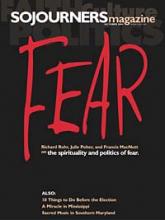At the regional airport in Waco, on the third day
of the war, we stand barefoot, as if on sacred ground.
As each in turn is beckoned, we file mutely past
the metal box that peers into our carry-ons and coats,
examines our watches, our wallets, our shoes.
Behind the box, the guards, solemn as celebrants,
peer into the mysteries of a sleek leather case
and tailored trench coat. Next, a green backpack
with crayon-colored patches slides humbly through.
In one gray plastic bin a lilac cardigan, neatly folded,
nestles against a small black canvas tote. As they slide
into the box, a guard frowns, leans closer to the screen,
then halts the machine, pointing to something
invisible to us. With brows knit, the guards stare
at the image while we wait. Then one flips a switch
and the bin pops out. She gently lifts the doll-sized bag
onto a metal table and gingerly pulls out a coil
of beadstiny spheres of faceted glass that alternate
with brass dots like BBs. Smiling, she elevates
serpentine rounds whose decades dangle blameless
before our fear. From where I stand, I see the curve
of their connection, and the silver cross they bend to.
In its rolled labyrinth, the spaces between prayers caught
the attention of the machine. The glass beads, smoothed
by generations of faithful touch, were barely visible,
the cross blank, indecipherable, until human hands
raised it, turned to reveal the hidden figure of torture,
the agony of the innocent at the hands of dying power,
that has not ceased while armies march
and pilgrims meekly kneel to shed their shoes.
Read the Full Article
